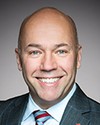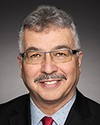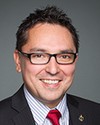Thank you very much.
Good afternoon, Mr. Chairman, committee members, and distinguished witnesses and guests.
My name is Lynne Groulx. I'm the executive director of the Native Women's Association of Canada. My colleague Amy, who is with me here, is a senior manager at NWAC. She's also a researcher par excellence, and she will probably be able to answer many of the questions that you might have on this subject.
First, I'd like to acknowledge the Algonquin peoples on whose traditional territory we are meeting today.
Thank you for the opportunity to present. I am a Métis woman of mixed Algonquin and French descent. I bring with me the voices of my ancestors, the concerns of aboriginal women from across Canada, and the hopes of our future leaders, our youth.
NWAC is the national aboriginal organization in Canada that represents the interests and concerns of aboriginal women and girls. NWAC is made up of provincial and territorial members' associations from across the country. Our network of first nations and Métis women spans north, south, east, and west, into urban and rural on-reserve and off-reserve communities.
We've all read the staggering headlines reporting the high rates of suicide among aboriginal youth, including some girls as young as nine years old. In light of these recent tragedies, I encourage all of you to join me in picturing someone in your life who you deeply care for, whether it be a family member, a friend, or a colleague. For me, I envision my own daughter, a 17-year-old aboriginal woman full of potential and enthusiasm for life. It is devastating to hear on the news that another one of our communities is struggling with this issue of youth suicide. The thought of losing my own daughter to suicide is absolutely unbearable.
In Canada, we must act quickly and compassionately to address this urgent crisis occurring in our aboriginal communities. We must allow the reality and the impacts of these suicides not only to touch our hearts but to drive us to take action now. I cannot stress this enough. Every single life matters.
The forced assimilation through discriminatory government practices such as the Indian Act, residential schools, the sixties scoop, and Bill C-31 have tremendous negative impacts on the health and well-being of aboriginal people. Socio-economic and cultural factors that contribute to the suicide crisis among aboriginal people include but are not limited to: poverty, unemployment, lack of access to health and social services, substandard housing, food insecurity, and the loss of culture, language, and the land.
Many continue to suffer the impacts of these policies generations later, including my own daughter. Aboriginal women and girls, their families, and their communities continue to experience anxiety, depression, homelessness, post-traumatic stress, and other mental health problems and illnesses that can contribute to harmful behaviours such as drug and alcohol abuse, self-harm, and suicide.
For decades, researchers have been reporting and continue to report various high suicide rates among adults and youth in our aboriginal communities that are several times higher than rates among non-aboriginal peoples. In the past year, the community of Bearskin Lake First Nation in northern Ontario declared a state of emergency after a series of deaths, including that of a 10-year-old girl. Then, the Pimicikamak Cree Nation in northern Manitoba, over a three-month period, had six youth suicides. In the month of March, Attawapiskat First Nation in northern Ontario declared a state of emergency after 100 people had attempted suicide since September 2015 alone.
In the latest news reports, Stanley Mission, La Ronge, and Deschambault Lake in northern Saskatchewan lost five young girls aged 10 to 14 within a week, because of suicide. These innocent children, who should be outside playing and enjoying their youth, have lost hope and are choosing to end their lives. For many isolated aboriginal communities, suicide or attempts at suicide have become normalized behaviour.
Recently, NWAC collaborated with Statistics Canada on an article, “Past-year suicidal thoughts among off-reserve First Nations, Métis and Inuit adults aged 18 to 25: Prevalence and associated characteristics”. Some of the key results do not come as a surprise. At 27%, the prevalence of lifetime suicide thoughts among young adults was almost double that of their non-aboriginal counterparts, at 15%. Most interestingly, aboriginal young women in particular showed a trend towards a higher prevalence of lifetime suicidal thoughts and were more likely than men to report mood or anxiety disorders and a bullying environment in school.
Research shows that high self-worth, strong family ties, strong social networks, and education can help prevent suicide in our communities. Also, in 2008, research by Chandler and Lalonde found that community and individual empowerment, control over personal lives, connection to culture, participation of women in local band councils, and the control of child and family services within the community protect against suicide.
The remote first nation of Bella Bella in British Columbia is a great model for preventing youth suicide by reconnecting the youth with land and culture. They built a youth centre to run youth programming 14 hours a day, seven days a week, which focused on traditional songs and culture, hunting and fishing activities, language revitalization, and education on their history and community.
There's also another indigenous youth program in terms of southern Treaty No. 3, which has identified five key priorities for moving forward. Those priorities are listed in a report and come from the youth themselves: one, the need for support to learn how to be a healthier family; two, crisis support workers; three, support around death, loss, and suicide; four, access to elders and culture; and five, safe spaces. We think this is a very interesting and informative report.
It's time to act on the knowledge and the need for change as voiced by our communities. We need to develop gender-appropriate and community-driven youth programs and services to help build self-esteem and self-worth and rebuild the connection among our youth to land and culture.
We acknowledge the Liberal government's recent commitment of $70 million in new funding over the next three years to address health and the suicide crisis involving indigenous peoples living on and off reserve territories. However, long-term solutions, improved resources, and gender and culturally aware mental health services, both on- and off-reserve, are urgently needed to effectively address the crisis and the underlying systemic issues contributing to the risk of suicide and suicidal thoughts in aboriginal youth across Canada.
It is too often easy for leadership and governments to forget about these matters as long as they do not occur on their doorsteps. If Canada refuses to spend the necessary funds on aboriginal communities, thereby denying children access to clean water, safe housing, education, and equitable health care, Canada is essentially deciding by doing so that aboriginal families and children matter less. This institutional form of racism allows for disproportionate spending.
On January 26, 2016, the Canadian Human Rights Tribunal issued a landmark ruling that found the federal government guilty of racially discriminating against first nations children in its delivery of child welfare services on reserves. The Canadian government was ordered to take immediate action to ensure its program budget responds to the unique needs of first nations children and their families and to apply Jordan's principle to all first nations children on- and off-reserve.
It has been nearly one year since that decision, and still the Liberal government has not adequately responded to the discriminatory underfunding of child welfare services and is also failing to properly implement Jordan's principle. Cindy Blackstock has stated that equity in social services can reduce the tragedy of youth suicide, but still the Canadian government has not acted on this.
Canada is a wealthy country, and our children deserve better. We must continue to work together to realize our children's potential and to help them have hope so that they can begin to accomplish their dreams. That requires us to take bold and immediate steps forward to create the change necessary and to make it a reality.
Let's show them that we are a caring and inclusive society where the future is bright. Thank you.





